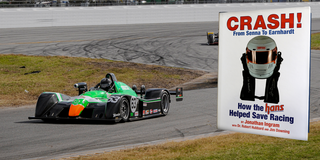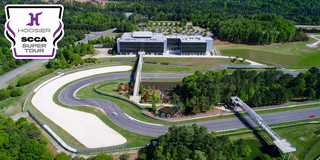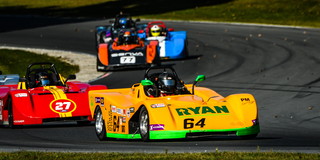
Words by Jonathan Ingram
Image by Jay Bonvouloir
Known for his endurance driving, Jim Downing first gained recognition at the inaugural SCCA National Championship Runoffs at the Riverside International Raceway in 1964. Since the Formula Vee race was the first on the schedule, Downing, who started his Formcar from the pole, became the first driver to ever take a green flag in the Runoffs at age 22.
Flash forward 57 years and Downing continues to compete in SCCA nationals and vie for the Runoffs in the Prototype 1 class on board his Mazda-powered Peach chassis built at his Downing/Atlanta facility in Chamblee, Ga.
“I wasn’t thinking about being a professional racer at that stage,” recalled Downing of his first Runoffs appearance. “I just wanted to race and Formula Vee was the cheapest possible way to go racing. It was a stretch to even afford that. My father, being a Depression era father, was not the kind of guy who gave you a car. He never thought much about racing, even though he was a car enthusiast himself.”
There was some endurance driving involved with that initial trip to the Runoffs, since it required Downing to tow his Formula Vee from Atlanta to California. “I bought a used hearse from a black funeral home and had an open trailer with the car and all the gear in back,” he said. “This was before freeways. I had a crew member who went with me who had one eye. The two of us shared the driving and drove cross country.”
Already a racing enthusiast who had taken a bus to watch the Indy 500 before he had a street car license, the racing at Riverside further set the hook for Downing, who had earned his SCCA competitor’s license in 1963 at the minimum age of 21. “We didn’t talk about drafting much at that time,” he said. “We just tried to get our cars around the track. It was a daunting track and we were just thrilled to be at this very famous place. When the SCCA first announced the Runoffs, you knew it was the place to be if you wanted to be involved in racing.”
Downing went on to win five IMSA championships in the professional series launched by former SCCA President John Bishop in 1969. Despite all his driving laurels, which include class victories at Daytona, Sebring and Le Mans, Downing is better known for helping to inspire and promote the HANS Device, auto racing’s first head restraint, which was invented by his brother-in-law Dr. Robert Hubbard.
It was Downing who posed the question to Hubbard: “Why can’t something be done about head injuries in racing?”
This year marks the 35th anniversary of Downing wearing a head restraint for the first time in an IMSA race at the Daytona International Speedway in November of 1986. He had already clinched a second Camel Light championship on board his Mazda-powered Argo JM-19. Hubbard, meanwhile, had been working on developing the HANS for several years during breaks from his work as a professor of biomechanical engineering at Michigan State.
The primary goal was to prevent basal skull fractures, which were becoming commonplace in auto racing. “We were very sure it was a serious safety device,” said Downing. “There was a lot of effort to get to that point. If I didn’t wear it, that would send the wrong message.”
Hubbard initially fashioned early models of racing’s first head restraint on his kitchen table in East Lansing, Mich. using card board and duct tape. The first device for use in competition was built from fiberglass and carbon fiber by a local fabricator, then painted with white gelcoat. Both Downing and Hubbard believed the HANS should work in all crash scenarios, which meant tethers connected to a driver’s helmet on either side as well as in the back. This, in turn, meant a relatively large, wrap-around collar to hold the tethers. The three tethers also provided better neck support for a driver under G loads.
Due to its rather shocking size and white color, the first HANS was dubbed the “Cinderella collar” by others in the paddock. “Folks were polite,” said Downing. “I’d won the championship two years in a row and they felt they ought to be polite at least when I was looking. I’m sure there were some stares and wry smiles. ‘What in the world is Downing doing?’
“The next one to wear it was Paul Newman,” he continued. “Paul was a very bright guy. He understood that wearing the HANS would help keep him racing and enabled him to race at GTP car at Watkins Glen. The first Model I devices with the full surround and tethers on the side really gave a driver some neck support.”
Recognizing that size was a problem when it came to application in all types of cars, especially those where the driver was in a reclining position, Hubbard first conceived of a smaller device using just two tethers in the rear in the mid-1980s. But it was not until the late 1990s that the smaller Model II was developed by HANS Performance Products in conjunction with Mercedes-Benz.
Officials of Mercedes, who were working in concert with the FIA as part of the international sanctioning body’s safety push, were initially persuaded to co-develop what became a frontal head restraint in part because some SCCA club racers had used the original Model I with good results. The size of the Model I did not pose a problem in open cockpit cars with upright seating such as Formula Fords and Formula Continental. During club events such as the June Sprints at Road America, Hubbard conducted field surveys and received favorable reports about crash protection without any usage problems from drivers who wore a HANS for the safety and in some cases due to a prior neck injury.
Following the arrival of the smaller second-generation HANS in 1999, CART, Formula 1 and NASCAR mandated head restraints due to the ongoing issue of basal skull fractures in those series. A basal skull fracture almost killed future F1 champion Mika Hakkinen in a crash in Adelaide, Australia in 1996 and later proved fatal to Dale Earnhardt in a crash on the last lap of the Daytona 500 in 2001.
The safety device Downing was instrumental in developing and marketing through the HANS Performance Products company co-owned by Hubbard, who died in 2019, has helped save hundreds of lives. Both Downing and Hubbard were inducted into the SCCA Hall of Fame in 2014 as a result of their safety work.
Downing last appeared in the Runoffs at the Virginia International Raceway in 2019. Now focused on restorations of race cars and other vehicles at Downing/Atlanta, he continues to race his Peach-Mazda as his schedule allows.
Editor’s note: Jonathan Ingram is the author of the book written with Jim Downing and Dr. Robert Hubbard titled, “CRASH! From Senna to Earnhardt – How the HANS Helped Save Racing.” The book has a five-star rating on Amazon.










